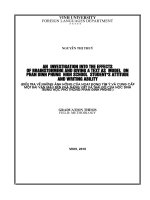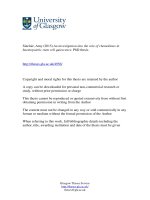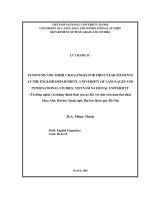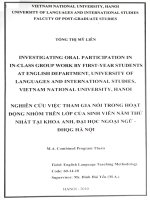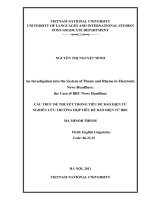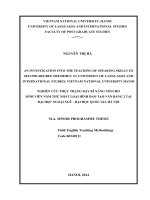INVESTIGATION INTO THE TEACHING OF SPEAKING SKILLS TO SECOND-DEGREE FRESHMEN AT UNIVERSITY OF LANGUAGES AND INTERNATIONAL STUDIES, VIETNAM NATIONAL UNIVERSITY HANOI
Bạn đang xem bản rút gọn của tài liệu. Xem và tải ngay bản đầy đủ của tài liệu tại đây (2.25 MB, 72 trang )
VIETNAM NATIONAL UNIVERSITY, HANOI
UNIVERSITY OF LANGUAGES AND INTERNATIONAL STUDIES
FACULTY OF POST-GRADUATE STUDIES
***
NGUYỄN THỊ HÀ
AN INVESTIGATION INTO THE TEACHING OF SPEAKING SKILLS TO
SECOND-DEGREE FRESHMEN AT UNIVERSITY OF LANGUAGES AND
INTERNATIONAL STUDIES, VIETNAM NATIONAL UNIVERSITY HANOI
NGHIÊN CỨU THỰC TRẠNG DẠY KĨ NĂNG NÓI CHO
SINH VIÊN NĂM THỨ NHẤT LOẠI HÌNH ĐÀO TẠO VĂN BẰNG 2 TẠI
ĐẠI HỌC NGOẠI NGỮ - ĐẠI HỌC QUỐC GIA HÀ NỘI
M.A. MINOR PROGRAMME THESIS
Field: English Teaching Methodology
Code: 60140111
HANOI, 2014
VIETNAM NATIONAL UNIVERSITY, HANOI
UNIVERSITY OF LANGUAGES AND INTERNATIONAL STUDIES
FACULTY OF POST-GRADUATE STUDIES
***
NGUYỄN THỊ HÀ
AN INVESTIGATION INTO THE TEACHING OF SPEAKING SKILLS TO
SECOND-DEGREE FRESHMEN AT UNIVERSITY OF LANGUAGES AND
INTERNATIONAL STUDIES, VIETNAM NATIONAL UNIVERSITY HANOI
NGHIÊN CỨU THỰC TRẠNG DẠY KĨ NĂNG NÓI CHO
SINH VIÊN NĂM THỨ NHẤT LOẠI HÌNH ĐÀO TẠO VĂN BẰNG 2 TẠI
ĐẠI HỌC NGOẠI NGỮ - ĐẠI HỌC QUỐC GIA HÀ NỘI
M.A. MINOR PROGRAMME THESIS
Field: English Teaching Methodology
Code: 60140111
Supervisor: Assoc. Prof. Dr. Trần Xuân Điệp
HANOI, 2014
i
DECLARATION
I hereby certify that this minor thesis entitled “An Investigation into the Teaching
of Speaking Skills to Second-degree Freshmen at University of Languages and
International Studies, Vietnam National University, Hanoi” is the result of my own
work in partial fulfillment of the requirements for the degree of Master of Arts in
English Teaching Methodology at Faculty of Post-Graduate Studies, University of
Languages and International Studies, Vietnam National University Hanoi. The research
has not been submitted to any other universities or institutions wholly and partially.
Hanoi, 2014
Nguyen Thi Ha
ii
ACKNOWLEDGEMENTS
First and foremost, I would like to express my sincere gratitude to my supervisor,
Assoc. Prof. Dr. Trần Xuân Điệp, for his considerable encouragement, clear and
constructive advice and especially for his valuable corrections throughout this study.
There is no doubt that without his comprehensive instructions, this thesis would never
have been accomplished.
I also wish to give my big thank you to the lecturers at Post Graduate Studies who
have delivered lectures with knowledge being of great significance to the completion
of this study.
I am very thankful to the teachers and students at In-Service Department,
University of Languages and International Studies for their active participation in the
survey questionnaire and their acceptance of my classroom observations.
My thanks also go to a large number of researchers whose important ideas and
notions are exploited and developed in the study.
Last but not least, I would like to send my heartfelt gratitude to my family and
friends who are forever a great source of endless love, care and support.
iii
ABSTRACT
This study examines the current situation of teaching speaking skills to the
second-degree freshmen at the In-Service Department, University of Languages and
International Studies, Vietnam National University Hanoi. It also aims at exploring the
mismatches between learners’ expectations and teachers’ assumptions in this context.
In order to seek the answers to these questions, survey research was employed in this
study. Data was collected through two instruments being questionnaires and classroom
observations, and then analyzed by descriptive statistics. After all, some
recommendations for teachers were made so that they can deliver a more successful
speaking lesson in which learners are motivated to occupy much of the talking time
with an acceptable level of language. It is expected that the findings of the research is a
reliable source of reference for the teachers in the department as well as teachers of
similar teaching contexts.
iv
TABLE OF CONTENTS
DECLARATION i
ACKNOWLEDGEMENTS ii
ABSTRACT iii
TABLE OF CONTENTS iv
LIST OF ABBREVIATIONS vii
LIST OF APPENDICES viii
LIST OF FIGURES AND TABLES ix
PART A: INTRODUCTION 1
1. Rationale 1
2. Objectives of the study and research questions 1
3. Significance of the study 2
4. Scope of the study 2
5. Method of the study 2
6. Design of the study 3
PART B: DEVELOPMENT 4
Chapter 1: LITERATURE REVIEW 4
1.1 Theoretical background of speaking skills in language learning 4
1.1.1 Definition of speaking 4
1.1.2 Factors affecting English speaking abilities 4
1.1.3 Some problems in learners’ speaking performance 5
1.2 Theoretical background of speaking skills in language teaching 6
1.2.1 Accuracy or fluency in the teaching of speaking 6
1.2.2 Phases in teaching speaking 7
v
1.2.3 Teachers’ characteristics 7
1.3 Characteristics of a successful speaking lesson 8
1.4 Review of previous studies related to the research area of the thesis 10
Chapter 2: METHODOLOGY 13
2.1 Research settings 13
2.1.1 Time allocation and the textbooks 13
2.1.2 Learning and teaching environment 13
2.1.3 The teachers 14
2.1.4 The students 14
2.2 The study 15
2.2.1 Research method 15
2.2.2 Subjects 16
2.2.3 Data Collection Instruments 16
2.2.4 Data collection procedures 17
2.2.5 Data analysis method 17
2.2.6 Data Analysis 18
Chapter 3: FINDINGS AND DISCUSSIONS 34
3.1 Findings and Discussions 34
3.1.1 Research Question 1 34
3.1.2 Research Question 2 35
3.1.3 Research Question 3 37
3.2 Recommendations 38
vi
3.2.1 Managing speaking turns to ensure even participation 38
3.2.2 Creating a cooperative atmosphere 38
3.2.3 Establishing good rapport with students 39
3.2.4 Combining the textbook with other authentic relevant materials 39
3.2.5 Varying speaking activities 39
PART C: CONCLUSION 44
1. Recapitulation of main ideas 44
2. Limitations of the study 45
3. Suggestions for further studies 46
REFERENCES 47
APPENDICES I
vii
LIST OF ABBREVIATIONS
CLT = Communicative Language Teaching
ELT = English Language Teaching
ULIS = University of Languages and International Studies
VNU = Vietnam National University, Hanoi
viii
LIST OF APPENDICES
Appendix 1: Survey questionnaire for students
Appendix 2: Survey questionnaire for teachers
Appendix 3: Classroom observation checklist
Appendix 4: Sample of the speaking activity: Song
Appendix 5: Sample of the communicative game: Spot the difference
Appendix 6: Sample of the communicative game: What is the word?
Appendix 7: Sample of the speaking activity: Question and answer
Appendix 8: Table of contents of Interactions Listening and Speaking textbook
ix
LIST OF FIGURES AND TABLES
Figure 1: Students’ attitudes towards English speaking and their effort in
learning.
Figure 2: Students’ participation in their English speaking lessons
Figure 3: Psychological reasons for students’ reluctance to speak English
Figure 4: Students’ linguistic difficulties in learning to speak English
Figure 5: Students’ assessment of the core English speaking textbook
Figure 6: Students’ talking time in the English speaking lessons and their
expectations of their teachers’ talking time
Figure 7: Students’ feedbacks on their teachers’ corrections
Figure 8: Students’ evaluation of their English speaking class
Figure 9: Students’ suggestions for ways to encourage them in the English
speaking class.
Figure 10: Teachers’ attitudes towards the importance of English speaking skills
Figure 11: Teachers’ evaluation of their students’ English speaking ability
Figure 12: Students’ difficulties in learning to speak English from the viewpoint
of teachers
Figure 13: Teachers’ opinion in Communicative Language Teaching
Table 1: Students’ feedbacks on their teachers’ activities in the presentation,
practice and production phases
Table 2: Students’ learning preferences
Table 3: Teachers’ difficulties in their English speaking lessons
Table 4: Results of classroom observations
18
19
20
20
21
22
24
25
26
28
28
29
30
23
27
31
32
1
PART A: INTRODUCTION
1. Rationale
English, as an international language, has become increasingly important in the age
of globalization and economic integration. A good command of English helps learners
substantially in finding good jobs in Vietnam; however, Vietnamese learners of English
are often described as having no ability to communicate in the target language. This is
possibly the most important reason why a huge number of non-English-majored graduates
decide to come back to school to obtain another degree majored in English. For these
part-time students, the ability to communicate fluently and effectively in the target
language has been of great significance. A large number of studies have been conducted
to help full-time undergraduates improve their English ability yet only a small amount of
research caters for the needs of part-time adult English learners. Simultaneously, in the
author’s opinion, this type of learners has some different characteristics from other
subjects. One of those is that these students are highly motivated and willing to devote
time, energy and financial resources to their study of English, yet a considerable number
do not know how to transform motivation into action; therefore, feel stuck in their study.
This research is done with the great expectation to provide a closer look at English
speaking teaching and learning in everyday classroom and assist teachers and learners
with better teaching and learning decisions. Generally, all these gaps have encouraged the
researcher to conduct the research “An Investigation into the Teaching of Speaking Skills
to Second-Degree Freshmen at University of Languages and International Studies,
Vietnam National University Hanoi”
2. Objectives of the study and research questions
This study targets at addressing the following issues
To investigate the current situation of teaching speaking skills to the second-degree
freshmen in the In-Service Department, ULIS, VNU
To explore the mismatches between learners’ expectations and teachers’
assumptions
2
To suggest measures to help teachers improve their teaching of English speaking
skills
The above objectives can be realized through these research questions:
1. What is the situation of teaching speaking skills to second-degree freshmen at the
In-Service Department, ULIS VNU?
2. What are the mismatches between second-degree learners’ expectations and their
teachers’ assumptions?
3. What should teachers do to improve their students’ learning of English speaking
skills?
3. Significance of the study
English is now an indispensable instrument of communication and it is being learnt
by diverse types of learners. Thus, the English teaching methods should vary in order to
satisfy and suit each type’s needs. It requires the ability to be sensitive to the educational,
institutional and social contexts in which foreign language learning and teaching take
place. In such a circumstance, it is desirable that English language teachers at In-Service
Department, ULIS VNU should put a strong emphasis on working out the way to improve
their students’ English speaking ability. As such, this study will serve as a reference
material not only for teachers of In-Service Department, ULIS VNU but also for teachers
of similar situations elsewhere who wish to improve their English speaking lessons.
4. Scope of the study
Concerning the scope of the study, some of the following things should be taken
into consideration. Firstly, this study focuses on developing learners’ fluency rather than
accuracy in their English speaking. Secondly, the study involves the second-degree
freshmen at the In-Service Department, ULIS VNU who are highly motivated in learning
English yet desperately need some instructions to go the right way.
5. Method of the study
This is a survey research with the use of two instruments: questionnaires and
observations. All comments, remarks, recommendations and conclusions were based on
the data analysis. Survey research has proved to be the best choice for this study as the
3
study was aimed at investigating the current situation of teaching speaking skills to
freshmen within a certain context. The combination of different instruments used in this
research would help to gain reliable data and help the researcher have a deep insight into
the circumstance.
This study employed qualitative data collection instruments including
questionnaires with open-ended questions and classroom observations. There were survey
questionnaires for both teachers and students, each one contained carefully designed
questions and could provide comprehensive understanding of the situation.
Class observations were used to provide triangulated data (teachers, students and
the researcher). The class observations may identify gaps between what the teachers said
in the questionnaires and what they actually did in their classroom.
6. Design of the study
The study consists of 3 parts.
Part A: Introduction is a brief description of the research including the rationale, scope,
subjective, research questions, method, and design of the study.
Part B: Development is the main part of the study, which is divided into 3 chapters:
Chapter 1: Literature Review presents theoretical background of the study and
review of the previous related studies.
Chapter 2: Methodology provides background information on the participants,
instruments, procedures of data collection, and method of data analysis
Chapter 3: Findings and Discussion presents the findings on the current situation
of teaching speaking skills at In-service Department, ULIS, VNU. After that, some
recommendations are made on the basis of these findings
Part C: Conclusion gives some concluding remarks, presents the limitations and gives
suggestions for further studies.
4
PART B: DEVELOPMENT
Chapter 1: LITERATURE REVIEW
1.1 Theoretical background of speaking skills in language learning
1.1.1 Definition of speaking
In this part, the definition of speaking would be clarified. In language teaching, we
often talk about four macro language skills (speaking, listening, reading and writing) in
terms of their direction and mode. Language generated by the learners (speaking and
writing) is considered productive while language directed at the learners (reading and
listening) is known as receptive language (Savignon: 1991). Mode refers to the medium
of language (whether it is aural/oral or written). For this classification, “speaking is the
productive, oral skill” (Bailey and Savage 1994: 2).
According to Florez (1999: 1), speaking is “an interactive process of constructing
meaning that involves producing, receiving and processing information” (cited in Bailey
and Savage 1994). It is “often spontaneous, open-ended, and evolving”.
To sum up, speaking is an oral skill which requires learners to make much effort to
produce the language without too much time planning.
1.1.2 Factors affecting English speaking abilities
There are many factors that influence the success or failure in learning English
speaking. However, the two most important factors are motivation and attitude (Gardner
and Lambert: 1972)
Motivation is seen as “a key consideration in determining the preparedness of
learners to communicate, (Gardner, 1985: 10). Harmer (2001) defines motivation simply
as “some kind of internal drive which pushes someone to do things in order to achieve
something” According to Carroll (1962), motivation decides the amount of time a learner
will spend on language learning. She claims: “The more motivation a learner has, the
more time he or she will spend on learning an aspect of a second language” (Carroll,
1962). Motivation not only plays an important role in learners’ learning but it also helps
the teacher. Lile (2002) confirms that “Motivation is the backbone of any classroom.
When the students are motivated, the teacher can perform his/her job the best.” Teachers
5
are often familiar with two basic types of motivation: extrinsic motivation and intrinsic
motivation. Harmer (2001) states that extrinsic motivation is caused by external factors
such as the need to pass an exam or the hope of possibility for future travel, etc. In
contrast, intrinsic motivation is caused by internal factors like the enjoyment of the
learning process itself or by a desire to make them feel better. It can be concluded that
motivation is significant in foreign language learning because when learners set the goal
of learning a foreign language; motivation helps them try tirelessly and have a positive
attitude towards language learning.
Attitude is the second factor which has an influence on language learning. Gardner
and Lambert (1972) defined attitude as the persistence that a learner has to follow an
object. Language learning attitude has a relationship to motivation. Language learners
who have more extrinsic or intrinsic motivation will have the more positive attitude than
those without motivation or who consider language learning a compulsory subject.
Another factor frequently mentioned is learning strategies. Within second or
foreign language education, a number of definitions of language learning strategies have
been used by key figures in the field. Tarone (1983:67) defined a language learning
strategy as “an attempt to develop linguistic and sociolinguistic competence in the target
language to incorporate these into one’s interlanguage competence”. Rubin (1987:22),
later, wrote that language learning strategies “are strategies which contribute to the
development of the language system which the learner constructs and affect learning
directly”. In their seminal study, O’Malley and Chamot (1990:1) defined language
learning strategies as “the special thoughts or behaviors that individuals use to help them
comprehend, learn, or retain new information”.
1.1.3 Some problems in learners’ speaking performance
According to Ur (1996), there are a number of problems in learners’ speaking
performance as follows.
Inhibition: Learners are often inhibited from trying to say things in foreign
language because they are worried about making mistakes, fearful of criticism, or losing
face, or simply shy of the attention that their speech attracts.
6
Nothing to say: Teachers often hear learners complain they cannot think out
anything to say. They may have no motivation to express themselves beyond the guilty
feeling that they should be speaking.
Mother-tongue use: In a foreign language class, a number of the learners share
the same mother tongue; therefore, they tend to use their mother tongue instead of trying
to speak in the target language for many reasons: firstly, it is easier to use. Secondly,
they fell unnatural to speak to one another in a foreign language. Lastly, they feel less
“exposed” if they are speaking their mother tongue.
1.2 Theoretical background of speaking skills in language teaching
1.2.1 Accuracy or fluency in the teaching of speaking
Nunan (1999) emphasizes that accuracy in language speaking teaching involves
the correct use of vocabulary, grammar and pronunciation. In controlled and guided
activities, accuracy is usually the focus and the teacher makes it clear from feedback that
accuracy is important. Ongoing correction is often appropriate during accuracy activities.
Harmer (2001) noted down that fluency can be considered to be “the ability to
keep the talk going when speaking spontaneously” (pp.104-109). When speaking fluently,
students should be able to get the message across with whatever resources and abilities
they have, regardless of grammatical and other mistakes.
According to Bailey (2005), an important concept for teachers to understand is that
fluency and accuracy often work against each other while students are still developing
their proficiency at beginning or pre-intermediate levels. Before grammar rules become
automatic and while learners are still acquiring essential vocabulary items, simultaneously
applying the rules and searching one’s memory for the right words can be a laborious
mental process, which slow down the learners’ speech and make them seem awkward and
embarrassed. Likewise, language learners can sometimes speak more quickly, without
much care of applying the rules they have learnt, but doing so may decrease their
accuracy.
In short, students should be encouraged during fluency activities. In feedback
afterwards, on the other hand, favorable comments are needed to increase their accuracy.
7
1.2.2 Phases in teaching speaking
Byrne (1988) distinguishes three following phases to develop learners’ oral ability:
the presentation phase, the practice phase and the production phase.
In presentation phase, teachers are the center of learning and teaching activities.
They work as an information provider. What students usually do in this phase is to
observe and listen to the teacher, i.e. they passively receive information. Normally, they
are only asked to practice a role-play, dramatize a dialogue or do other speaking activities
at the end of this phase.
Unlike the presentation phase, at practice phase learners have to do most of the
talking as they are provided maximum amount of practice in the form of controlled and
guided activities to improve vocabulary and grammar knowledge as well as fluency of
speaking. The learners, at this phase, answer the teacher’s guided questions, discuss with
their partners to find new ideas related to the topic. At the end of the practice phase, Ur
(1996) suggested what the teacher should do is to enhance the learners’ fluency of
speaking. First, the learners must pay their full attention to the speaking activity. Second,
the target language must be clearly heard or repeated. Third, learners understand the
meaning of new materials and finally, short-term memory of the material must be created
for later use in the lesson.
At the last phase of learning speaking, production phase, learners are given
chances to speak English freely. Learners are provided with opportunities to speak
English by themselves in a real situation. Uncontrolled activities are also in the form of
individual work, pair work and group work. However, pair work and group work are of
great importance and effectiveness as all learners can have chance to participate in talks,
and they seem more confident and more motivated working with their peers. Moreover,
this can save a great deal of time.
1.2.3 Teachers’ characteristics
Though “the perfect set of personal qualities and characteristics for an effective
teacher has not been found” (Barry, 1993:94), it would be definitely true to say that in
order to involve students in classroom’s activities; teacher firstly should be one that
8
students respect and lay their trust on. The teacher’s prestige will make students feel safe
in the lesson and willing to participate in the activities. To support this point, Barry
(1993) mentions a number of characteristics that a teacher should have:
- Being natural: The teacher should present himself as a real person such as the feeling
of happiness, sympathy, annoyance or humor.
- Being warm: The teacher regards students as his fellow people, respects their
personal characteristics and is happy to have them around.
- Being pleasant: The teacher’s attitude towards students expresses his relaxation,
friendliness in the relationship with his students.
- Being approachable: An approachable teacher is the one who makes students feel
good about being with him and the one that students can come to see if they have
problems.
- Being tolerant: In learning a foreign language, students’ mistakes are inevitable. The
teacher needs to be tolerant with those mistakes instead of criticizing them tactlessly.
To establish a good relationship, it is vital that teachers should be cordial,
acceptant and tolerant; otherwise it can make students scared and afraid of speaking in the
class. Tsui (1996) found out that teachers’ intolerance of silence is one of five principal
factors affecting students’ reluctance in speaking (cited in Nunan, 1999:234).
Furthermore, in his investigation, Oxford (1998) also stated that the teacher’s
relationships with the students, the teacher’s attitude or the style conflicts between them
are major factors demotivating students’ participation.
It should be noted that not every teacher can have all the above characteristics, but
it can help improve a good rapport between the teacher and students. With such good
interaction during the lesson, it both creates a positive environment for learning and
enhances students’ participation in the activities.
1.3 Characteristics of a successful speaking lesson
Different people have defined a successful lesson in different ways. Ur, P. (1996)
provides characteristics of a successful speaking lesson as follows:
9
High learner’s talking time
Ur states that in a successful lesson: “as much as possible of the period of time
allotted the activity is in fact occupied by learner talk”. Thus, the main thing for teachers
is that they must accept the purposeful, useful noise. An increase in the volume of noise
may indicate that the activities are being enjoyed and students are interested in these
speaking activities. What teachers should do is to keep student’s communicative noise at
an acceptable level so that it does not disturb other classes. Moreover, the teacher should
give clear instructions for speaking activities in order to avoid uncommunicative negative
noise as they misunderstand the instructions.
High motivation
In every successful speaking lesson, students always have a strong desire for
participating in it. It can be seen clearly in Haycraft’s point of view (1978): “Motivation is
summed up briefly as the learners’ desire and need to speak – driving force that makes
them work hard, pay attention and so on”.
Motivation is the combination of many external factors such as the atmosphere in the
classroom, topics and speaking activities. Therefore, in order to create motivation for
students, the teacher should apply as many kinds of activities as possible which should be
interesting and familiar to them. Another point to bear in mind is that the activities and
the topics must be suitable to learners’ level since it creates a good condition for students
to take part in communication. As such, students are no longer afraid of being laughed at
by their friends when they make mistakes. Instead, they participate in the lesson so
eagerly that their task objective is achieved.
Even participation
Apart from high learners’ talking time and high motivation, even participation is
needed in a successful lesson. It means that everyone has chances to speak, not only the
minority of talkative excellent students and contributions are fairly evenly distributed. It
is said that a good teacher is someone asking students who do not always speak to put
their hands up for speaking tasks. All in all, a good speaking lesson is a place where all
students have opportunities to express themselves in the language they are learning and
10
the teacher knows the ability of each student and tries to find out suitable teaching
methods and techniques to encourage every student to express their ideas.
An acceptable level of language
The last characteristic of a successful language lesson that teachers should take into
consideration is an acceptable level of language from students. That is students express
themselves in utterances that are relevant and easily comprehensible. In other words, the
language must be at an acceptable level of accuracy. Simple language is suitable for
beginners meanwhile the language should be rich in vocabulary, sentence structures and
relevant linguistic means for intermediate or advanced students.
1.4 Review of previous studies related to the research area of the thesis
A relatively large number of researchers have conducted empirical studies to
examine the actual situation of learning and teaching English speaking skills and then
how to improve students’ speaking skills. Some of these studies are as follows.
Tsui A (1996) carried out a study to find out the challenges facing the teaching and
learning of speaking skills. The result of their research shows that learners’ low
motivation is the big problem. In the study, they also suggest some actions that teachers
should take to improve their learners’ motivation. Some very effective solutions may be
cited as follows: making instructional goals explicit to learners; breaking learning down
into different achievable steps; linking learning to the needs and interests of learners;
allowing learners to bring their own knowledge and perspectives into the learning
process.
Other studies were concerned about techniques of teaching speaking, for example
Hamzah & Ting (2009) conducted a qualitative and action research study on success of
using group work in teaching speaking in English classroom in a school called “SMK
Damai Jaya” in Malaysia. The participants in this study were 33 students and 3 English
teachers. Questionnaires, observations and interviews were used as data collection
instruments. The researchers carried out a series of questionnaires in Malay language
where students could provide their opinions about the group work activities to
improve speech skills and their consciousness of participation in those activities. The
11
observations were analyzed to understand the participation and the behavior of
students during the lessons, and the interviews were carried out with three English
teachers. The findings were that the participants expressed enthusiasm in group work
activities and proficiency in spoken language because they were secure of expressing
themselves in small groups which avoided anxiety to speak in another language.
Also, Hamzah & Ting (2009) suggested that “In order to get every student
participating in the group work, it is essential that the activities should be
appropriate to students’ level and could interest them to participate. Therefore,
making the students interested in the activity was the first step to conduct a successful
language learning activity.
Another technique named language games was mentioned in Urrutia & Vega
(2006) research study. The data suggested that speaking was the most difficult skill to
develop because students usually presented lack of vocabulary, shyness and fear of being
humiliated. Besides, the authors explained that students showed evidence about the
importance of implementing games in classroom for improving the speaking skills.
In Rama, Ying, lee & Luei Luei’s (2007) study, the participants expressed that
games allowed more than a half of students to improve communication in the
second language.
Other techniques to improve students’ English speaking skills can be seen in a
great deal of research. Some outstanding examples are Nugroho (2011) with animated
video, Khomah (2009) with jigsaw, Hanim (2011) with U-shape seating arrangement,
Awaliaturrahmawati (2012) with outdoor activities, Hartati (2012) with games,
Ristyawati (2012) with telling short story, Wijayani (2012) with stimulation, Salam
(2011) with Role Play and Sulistyatini (2011) with semantic mapping.
In Vietnam, a study entitled Teaching Speaking Skill(s) to non-majored MA
Students at VNUH was carried out by Nguyen Thi Thu Huong (2010) with the purposes
of finding out the current situations of learning and teaching of speaking skills to non-
English-majored MA students at Vietnam National University Hanoi and the reasons for
students’ unwillingness to speak English as well as teachers’ problems in teaching
12
speaking skill. The subjects of the study were non-English-majored MA students at
School of Graduate Studies and their teachers. The data collection instruments were
questionnaires and interviews. The findings showed that due to various reasons such as
variety in students’ level of language proficiency, lack of interesting topics, prior
experience in learning speaking, and fear of losing face, more than two thirds of the
students remained reluctant to respond to the teacher and kept quiet until they were
singled out to answer questions.
From the above studies, several conclusions can be drawn out. Firstly, these
studies were implemented with a view to having better insight into the teaching and
learning of English speaking skills. Secondly, students and teachers’ difficulties were
investigated and recommendations were made to improve learners’ speaking skills.
Lastly, the instruments employed in these studies were mainly questionnaires,
observations and interviews; therefore, the author also takes advantage of two of these
instruments to obtain data.
Summary
In conclusion, chapter 1 has presented some theoretical background knowledge
related to the topic of the study. It has discussed a definition of speaking skills, theory of
speaking skills in learning and teaching and presented a review of previous studies related
to the research area. The following chapter will display the detailed description of the
methodology, the procedures and the results of the study in the light of the above
discussed theories.
13
Chapter 2: METHODOLOGY
2.1 Research settings
2.1.1 Time allocation and the textbooks
The subjects of the study were second-degree freshmen at ULIS, VNU. There were
two options of class time for students to choose. One was from 18.00 to 20.30 every
weekday (five lessons a week) and the other was the combination of two evening
weekday lessons (18.00 – 20.30) and two afternoon weekend lessons (13.00 – 17.30).
Whatever the class time, one semester covered 180 periods (divided into 60 or 45 lessons
respectively).
The course, at the beginning level, aimed at providing students with general
knowledge of English grammar, vocabulary, pronunciation as well as developing
students’ four language skills with equal time allocation on these skills. At this stage, the
two sets of textbook Interaction Access and Interaction 1 (Silver Edition) published by
Mc Graw-Hill Companies were adopted. In each set there were four separate books for
individual skills named: Interaction Listening and Speaking, Interaction Reading,
Interaction Writing, and Interaction Grammar.
The Interaction Listening and Speaking was the speaking course book for first year
students. It was structured with a priority towards theme-based or topic-based approach,
including 10 chapters. Semester 1 dealt with Interaction Access (Elementary) and
semester 2 dealt with 6 chapters of Interaction 1 (Pre-Intermediate). The content of the
book was designed with topics related to social life, sports, work and leisure, eating
habits, education etc. which were familiar with students. The books’ table of contents can
be seen in Appendix 8. For each topic, the related vocabulary was presented
communicatively. Apart from the textbooks, teachers were strongly encouraged to
provide students with other relevant materials.
2.1.2 Learning and teaching environment
The learning and teaching of English took place at the main building of Foreign-
Language-Specialized High School which is located inside the campus of ULIS, VNU.
Proper facilities are an important factor for improving learning and teaching English yet
14
English classes here were equipped with basic facilities such as cassette players and
blackboard whereas modern equipment such as projectors and computers was not
available.
On the positive side, the number of students in each class was around 30, which is
considered to be relatively favorable to the process of teaching and learning of English
especially speaking skills. The adequate number of students was advantageous for
teachers to design and conduct speaking activities and these speaking activities were more
personalized to the needs of students.
2.1.3 The teachers
At In-service Department ULIS VNU, there were totally 14 teachers of English aged
from 24 to 43 who were responsible for teaching freshmen. The oldest teacher had more
than twenty years of teaching experience and the youngest just had nearly two years.
Teachers could be divided into two groups: the first group was the teachers who were
currently teaching English at this university; the other was the teachers who were
currently teaching English at other institutions. No matter what group they belonged to,
all of them graduated from the Faculty of English Language Teaching Education, ULIS
VNU, and roughly 70% of them had obtained or were learning to obtain the MA Degree
at Faculty of Post Graduate Studies at the university. These descriptions reflected the fact
that some of the teachers were so young and not experienced enough, which could cause
certain methodological difficulties in terms of the knowledge as well as the way to apply
communicative speaking activities in their teaching process. However, all the teachers
were energetic and well aware of the importance of the ability to communicate in English
and the teachers played a significant role in forming students’ ability of speaking.
2.1.4 The students
The total number of second-degree freshmen at In-service Department was
approximately 120 divided into four classes. This population had the following features.
an individual who was above the age of 22.
an individual who had already had a university degree, which was a requirement
for them to enroll in the course.

